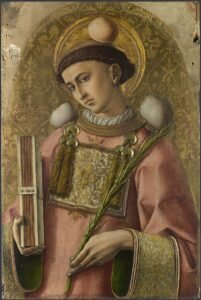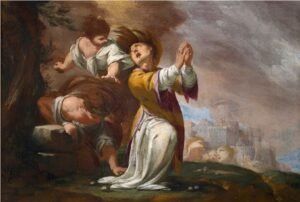Unleashing the Courage of St Stephen: 12 Facts on His Story of Unwavering Faith and Boldness
The inspiring story of St Stephen, a beloved figure in the Christian faith will amaze you. Although St Stephen lived almost two thousand years ago, his message of faith, courage, and love still resonates with believers around the world today.
As a deacon in the early Christian church, St Stephen was known for his powerful preaching and his dedication to serving the poor and marginalized. His ministry was marked by miracles and signs that drew many people to faith in Christ, but it also made him a target of persecution by the religious leaders of the time.
Despite the danger, St Stephen refused to back down from his message. His unwavering devotion to Christ and his willingness to stand up for what he believed in ultimately led to his martyrdom.
Through his life and legacy, St Stephen reminds us of the power of faith to overcome even the greatest challenges and of the importance of standing up for what is right, no matter the cost. So let us take a closer look at his story and allow it to inspire us to live lives of faith, courage, and love.

What is the story of St Stephens?
The story of St Stephen is one of faith, courage, and unwavering devotion to Christ. St Stephen was a deacon in the early Christian church, known for his powerful preaching and his dedication to serving the poor and marginalized.
According to the book of Acts in the Bible, St Stephen’s ministry was marked by miracles and signs that drew many people to faith in Christ. However, his bold preaching and his criticism of the Jewish religious leaders also made him a target of persecution.
Despite the danger, St Stephen refused to back down from his message. In a powerful speech before the Jewish council, he recounted the history of God’s faithfulness to his people and accused the religious leaders of rejecting God’s chosen one, Jesus Christ.
This speech was the last straw for his opponents, who became furious and dragged St Stephen outside the city to be stoned to death. As he lay dying, St Stephen prayed for his attackers, asking God to forgive them.
St Stephen’s martyrdom had a profound impact on the early Christian church. His courage and faithfulness in the face of persecution inspired many believers to remain steadfast in their own faith, even in the face of adversity.
Today, St Stephen is remembered as a model of Christian devotion and service. His legacy reminds us of the power of faith to overcome even the greatest challenges and of the importance of standing up for what is right, no matter the cost.
Was St Stephen the first martyr?
According to the book of Acts in the Bible, Stephen was stoned to death by an angry mob after he delivered a powerful speech accusing the Jewish religious leaders of rejecting Jesus Christ. This event is generally regarded as the first recorded martyrdom of a Christian.
However, it is important to note that there were other believers who were killed for their faith before Stephen. For example, the book of Matthew in the Bible records the story of John the Baptist, who was beheaded for his beliefs.
In addition, there were many other Christians who were persecuted and killed in the years following Stephen’s death, including the apostles Peter and Paul.
So while Saint Stephen is often referred to as the first Christian martyr, it is important to remember that his death was just one of many tragic events in the early history of the Christian church.
Regardless of whether he was the first or not, Stephen’s story continues to inspire believers around the world to stand up for their faith and to remain steadfast in the face of persecution. His unwavering devotion to Christ and his willingness to sacrifice his life for what he believed in is a powerful reminder of the true cost of discipleship.
In addition to his martyrdom, St Stephen is remembered for his powerful preaching and his dedication to serving the poor and marginalized. His life and ministry were a shining example of the love and compassion that Christ calls us all to embody.
Where was Saint Stephen martyred?
St Stephen was martyred in Jerusalem, which was then under Roman rule. The exact location of his execution is not known, but some sources suggest that it may have been at the city’s northern gate, near the site of the present-day Damascus Gate.
What was Stephens last word?
“Look,” he said,“I see heaven open and the Son of Man standing at the right hand of God.”
Who ordered St Stephens death?
St Stephen’s story lives on, inspiring people around the world to stand up for their beliefs and remain steadfast in the face of adversity.

But where are the relics of St Stephen today? Relics are objects or pieces of a saint’s body that are kept as a reminder of their life and teachings. In the case of St Stephen, his relics are believed to have been taken to Rome after his death and are now housed in the Basilica of Saint Lawrence outside the Walls.
How can I make a pilgrimage to see St Stephen?
If you’re wondering how you can make a pilgrimage to see St Stephen’s relics for yourself. Let’s explore some options!
The relics of St Stephen are housed in the Basilica of Saint Lawrence outside the Walls in Rome, Italy. This stunning basilica is located just outside the ancient walls of Rome and is easily accessible by public transportation.
The first step is to plan your trip to Rome. Research the best time of year to visit, taking into account weather and other factors that may affect your travel plans. Next, decide on your mode of transportation and make arrangements for accommodations in Rome.
Once you arrive in Rome, make your way to the Basilica of Saint Lawrence. The church is located in the lively neighborhood of San Lorenzo, just a short distance from the Termini train station. You can reach the Basilica by taking the metro to the San Lorenzo stop or by taking a bus to the nearby Piazzale Tiburtino.
As you approach the Basilica, take a moment to admire its beautiful facade and enter its hallowed halls. You will be welcomed by the stunning artwork, intricate architecture, and peaceful atmosphere that make the Basilica a truly special place.
Make your way to the altar where the remains of St Stephen are enshrined. Take a moment to reflect on his life and legacy, and offer a prayer of gratitude for the opportunity to be in his presence.
If you wish to make your pilgrimage even more meaningful, consider attending a Mass or other religious service at the Basilica. The church offers daily Masses in both Italian and English, as well as a variety of other devotional services.

Finally, take time to explore the neighborhood of San Lorenzo. This vibrant and eclectic district is home to a thriving student population, numerous cafes, and local markets. You may even wish to try some of the delicious Roman cuisine or attend a cultural event in the area.
I love traveling and traveling to see the saints is even better!
When we went to Rome is changed my life and my perspective on life going forward that I will always remember and be grateful for.
I’ve found a fun adventure HERE in Rome that you can use to make your trip there even better. Click on the picture to learn more about it.

What is the history of the Basilica of Saint Lawrence?
The Basilica of Saint Lawrence is a stunning church located in the heart of Rome. The church dates back to the fourth century, when the early Christian community in Rome was facing intense persecution. At the time, the church was known as the Titulus Lucinae, and it was a place where Christians could gather in secret to worship and pray.
Over the centuries, the church underwent several renovations and expansions, with the most significant changes occurring in the 16th and 17th centuries. During this time, many famous artists, such as Bernini, Borromini, and Cortona, were commissioned to create elaborate decorations and frescoes in the church, transforming it into the magnificent masterpiece it is today.
However, the most fascinating part of the history of the Basilica of Saint Lawrence is its connection to the life and death of Saint Lawrence himself. Saint Lawrence was a deacon in the early Christian church, and he was known for his charity and generosity towards the poor.
Legend has it that when the Roman authorities demanded that he turn over the church’s treasures, he presented them with the poor and needy, declaring that they were the church’s true treasures.
As punishment for his defiance, Saint Lawrence was sentenced to death by burning on a gridiron. It is said that as he was being burned alive, he joked with his torturers, saying,
“Turn me over, I’m done on this side!” – Saint Lawrence
His remains are enshrined beneath the church’s high altar, in a magnificent marble tomb that is adorned with beautiful sculptures and intricate carvings.
He is now recognized as the patron saint of cooks, comedians, and the poor.

The Basilica of Saint Lawrence is not only a place of great historical significance, but it is also a spiritual and cultural treasure. It is a testament to the resilience and perseverance of the early Christian community, and a reminder of the power of faith and charity in the face of persecution.
The next time you find yourself in Rome, take a moment to visit the Basilica of Saint Lawrence and experience the beauty and history of this remarkable church for yourself.
Which other saints are buried at The Basilica of Saint Lawrence?
Saint Justin, a philosopher and theologian who is considered one of the greatest Christian apologists of all time, is also buried at the Basilica. He was martyred in the second century for his defense of the Christian faith, and his writings continue to inspire and enlighten believers today.
The Basilica of Saint Lawrence is also home to the remains of Saint Eusebius, Saint Hippolytus, and Saint Cyriacus, among others. Each of these saints lived a life of devotion and service to God, and their memories are honored and celebrated at the Basilica.
As you walk through the hallowed halls of the Basilica of Saint Lawrence, you can feel the presence of these holy men and women who dedicated their lives to serving God and their fellow human beings. Their legacy lives on in the beautiful art and architecture of the church, and in the hearts of those who come to pay their respects and offer prayers of gratitude and praise.
If you have the opportunity to visit the Basilica of Saint Lawrence, take a moment to honor and remember these saints who have gone before us, and whose lives continue to inspire and uplift us today.
If you’re planning a trip to Rome, you may want to consider adding a visit to the Basilica of Saint Lawrence to your itinerary. The basilica is open daily, and visitors are welcome to attend mass and venerate the relics of Saint Stephen.
If a trip to Rome is not in your near future, there are still other ways to pay your respects to Saint Stephen. Many churches and cathedrals around the world have relics of Saint Stephen, and you may be able to find a local shrine or chapel where you can offer your prayers and devotion.
Why is St Stephen so important?
Now, you may be wondering why Saint Stephen is such an important figure in the Christian faith. Well, aside from being the first Christian martyr, Saint Stephen is also known for his powerful sermons and his unwavering faith in the face of persecution.
Through his life and teachings, Saint Stephen has become a symbol of courage, devotion, and selflessness. His story reminds us of the power of faith and the importance of standing up for what we believe in, no matter the cost.

So, whether you’re planning a trip to Rome or simply looking for inspiration in your daily life, Saint Stephen’s legacy is one that will continue to inspire and uplift you. Come and discover the incredible story of this remarkable saint and let the Spirit guide you on your own spiritual journey.
Why do we honor St Stephen?
As the first Christian martyr, Saint Stephen is a symbol of courage and devotion. He refused to renounce his faith, even in the face of persecution, and his steadfastness inspired countless others to do the same.
But Saint Stephen’s legacy extends far beyond his martyrdom. He was also a gifted preacher and a kind and compassionate person who dedicated his life to serving others. His teachings and example continue to inspire people of all faiths to live their lives with integrity and purpose.
What miracles did St. Stephen perform?
According to the Bible, Saint Stephen performed a number of miraculous acts during his lifetime. One of the most famous stories tells of how he was able to heal the sick and cast out demons through his prayers and intercession.
St. Stephen is the patron saint of deacons, stonemasons, and horses. But beyond these titles, he is also a symbol of courage, compassion, and unwavering faith.
How can St Stephen make me a saint?
St Stephen lived a life of profound devotion to God, even in the face of persecution and adversity. He embodied the virtues of kindness, forgiveness, and selflessness, and his unwavering commitment to his faith inspired countless others to follow in his footsteps.
By following the example of St. Stephen, we too can strive toward sainthood. We can cultivate a deeper relationship with God, practice acts of kindness and compassion towards others, and seek to live a life that is guided by faith and virtue. Through these efforts, we can become the best versions of ourselves and make a positive impact on the world around us.
I encourage you to take some time to reflect on the life and legacy of St. Stephen. Let his example inspire you to live a life of purpose and meaning, and let his unwavering faith guide you towards a deeper connection with God. Together, let’s embrace the transformative power of St. Stephen and work towards a more compassionate and just world.
Are You Inspired?
Did today’s lessons provide you with any inspiration? I genuinely appreciate studying and discussing the lives of the saints.
Visit our blog HERE for a list of additional notable saints.
Do you have a few extra minutes to explore another saint?
Why not research:
- The Annunciation to Mary: 9 Cataclysmic Facts how Faith and Surrender Changed the World
- 10 Facts Unveiling the Beauty of “The Annunciation Triptych”: A Masterpiece of Renaissance Art
- St. Patrick: 14 Awe-inspiring Aspects about his Life and Legacy
- St. Louise de Marillac: 15 Inspiring & Unknown Facts on her Life
Have you thought about coming along every day to learn more about the Saint of the Day? If you would like to receive my daily saint emails in your inbox, kindly take a moment to join up. I’ll keep it short since I know you’ve got a lot on your plate, but I truly want to tell you more so you can learn from my experience and develop into a warrior like me.
As a special gift, I’ll also give you a free screensaver for your phone. After you submit the form, I’ll send you the link to download the updated screensaver. Enjoy!
Well, that’s all for today.
I’ll see you back tomorrow with another Saint of the Day to inspire you!
God bless you,
-Priscilla


